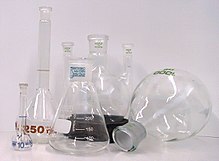Laboratory flask
In chemistry or in laboratories in general, bulbous vessels (usually glass vessels) are called flasks (from Middle High German kolbe, "flask, glass flask", also called kolbenglas as flask-shaped glassware). Size, shape and material (for example: glass, borosilicate glass, PE, Teflon) vary depending on the intended use. Flasks used for distilling or heating liquids are usually made of heat-resistant borosilicate glass.
The illustration shows, from left to right, two volumetric flasks of different sizes (flat bottom, adjusted to specific volumes, used, for example, for the preparation of measured solutions), an Erlenmeyer flask (flat bottom and wide neck, used, for example, for titration), a three-neck flask (reaction vessel) and a rotary evaporator flask (for evaporating liquids at elevated temperature and vacuum). In addition, there are many other embodiments of glass flasks: upright flasks (similar to a round bottom flask, but with a flat bottom), pear or Walter flasks, Kjeldahl flasks (used in analysis for nitrogen determination according to Kjeldahl), two-neck flasks and three-neck flasks (used in synthesis), and pointed flasks (used as collection vessels under a spider). Most of these flasks are provided with a standard ground joint, so that simple installation in complicated glass apparatus is possible.
In electrical engineering, a piston creates the separation between the gas mixture of the earth's atmosphere, to which humans are accustomed, and a special environment inside the piston (vacuum, air, steam or gas filled with noble gases at low pressure, e.g. mercury vapour), which is produced for the particular purpose. These are usually made of glass or ceramics, more rarely of metal (steel). The materials must be sufficiently gas-tight and withstand mechanical stress (pressure difference!). Electrical connections are made by means of fused or insulated lead-through wires. Example: pinch foot. The term bulb is very vividly illustrated in incandescent lamps, older electron tubes cathode ray tubes and mercury vapour rectifiers by their often bulbous shape.

Various glass bulbs
.jpg)
Glass bulb of Marie Curie.
See also
- Round bottom flask
- Sulphur Flask
Search within the encyclopedia